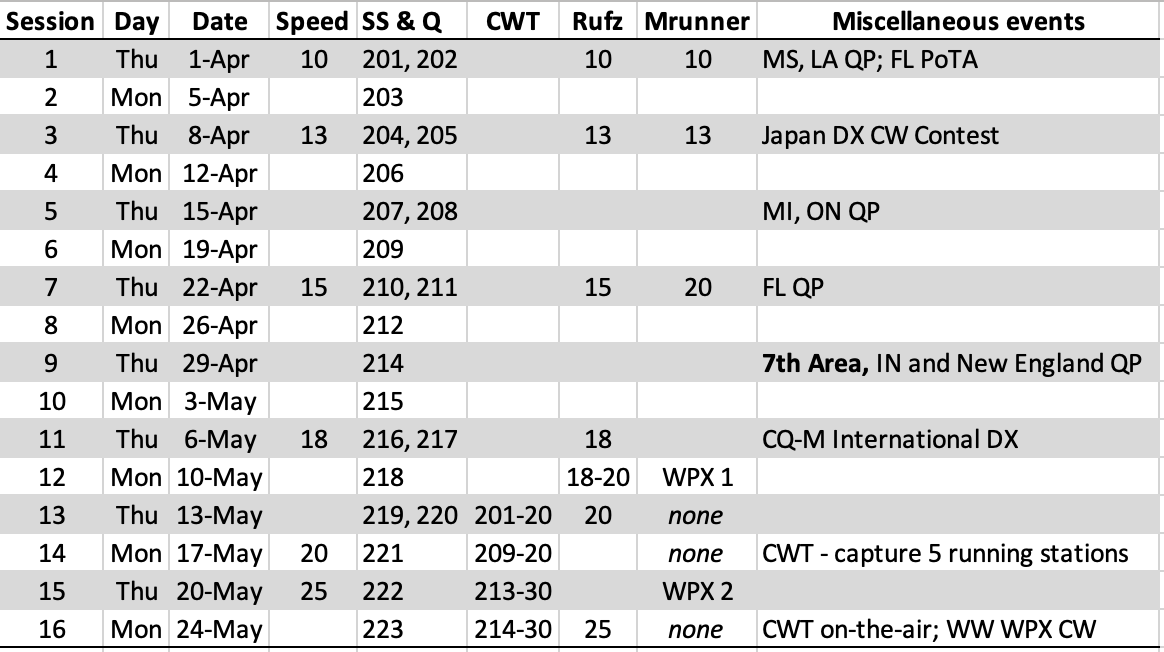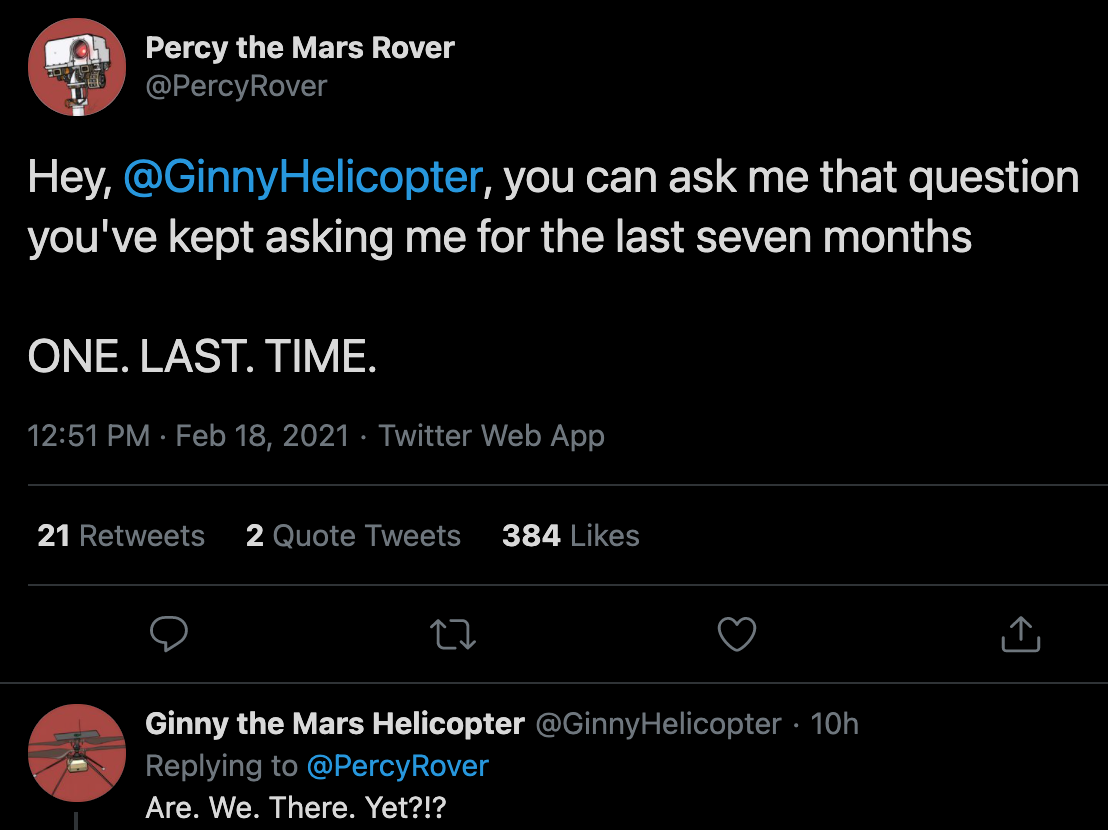Sending in-class:
- Compose two “Dad Jokes” to send. For example: “Two guys stole a calendar. They got six months each.” (Or: “What do you do with an elephant with three balls? Walk him and pitch to the rhino.”)
- We’ll practice more sending of longer passages. Revisit the Wikipedia front page: https://en.wikipedia.org/wiki/Main_Page and pick a couple of items from Did you know… or On this Day — there is an extensive “Archive” link that will add variety — and summarize them for sending via CW. We’ll probably only have time for one, but in case we can do another, let’s do.
- We’ll do an exercise where you’ll call a classmate on Zoom, ask a simple question, they’ll reply, then onto the next classmate. Suggested subject areas: weather, HF rig, antenna, dinner, car, next vacation destination. The added variety is listening for your call sign and sending a classmate’s. If you are unable to copy, send a ? for resend. An exchange might look like this:
W7PEZ de WT8P what is your rig?
My rig is icom ic7300WS6Y de W7PEZ how big is hexbeam?
The hexbeam is 5280 feet.KJ7IZT de WS6Y …
For the last two sessions, take some opportunity to get on the air with each other or visit sked.groups.io to see if anyone’s on. (SST runs Sunday and Friday now.) I don’t see any interesting and straightforward CW contests for the next two weeks. Other options include SOTA activations or the ARRL Inter DX contest (exchange you send is simply RST and state). In a pinch, you can use Zoom.
The class material for session 15 has you listening to three short stories and three QSOs. The first time you listen to it (at 20wpm) just hear the rhythm, then try again with a slower version and begin head-copying with your eyes closed. Beware that the short stories are pretty long. It is fine if you just do one and pinkie-promise to do the others in the unverifiable future.
The QSOs are slightly mean, IMO. There is one person from Dallas who is named Dallas, and in another QSO, the person is from Trevor (WI). From a practical point of view, I never send my QTH as Sammamish (or, God forbid, Issaquah) when I can use Seattle and people know where that is.
Let me know if you are interested in doing the Intermediate class or want to discuss. Happy to give you the straight dope on it. Also see the blurb I wrote below. The Long Island CW Club also has some interesting offerings, including CW Meditation ( — — — — — — — )
The main goal of the intermediate class is to build up head-copying and sending fluency so you’ll feel more comfortable getting on the air to contest or ragchew. The guide is here
Sessions work out to:
- Sessions 1 – 3: send and receive 10-13 wpm, Morse Runner, RufzXP
- Sessions 4 – 6: 13-15 wpm, Morse Runner, RufzXP
- Sessions 7 – 10: 15-18 wpm, Morse Runner and RufzXP
- Sessions 11 – 13: 18-20 wpm, Morse Runner and RufzXP
- Sessions 14 – 15: 20-25 wpm, Morse Runner and RufzXP, CWT
- Session 16: a taste of receiving 25-30 wpm, though if you’ve done CWT, you have done that already
The bulk of the class syllabus accomplishes this through head-copying short stories, QSOs and snippets from “CWT“, the Wednesday contesting event at 1300z, 1900z and 0300z. If you have a panadapter, watch 40m (~7.030, evening) or 20m (~14.030, noon) light up for the hour that’s going on.
The short stories will never reveal mysteries of the universe (ahem), but their simple sentences help ease copying. For example:
A Storm.
Laura looked out the window. A storm was coming. The sky was getting darker. The wind was starting to blow….
The QSOs are all of the rag-chewing variety, e.g., very free-form, sometimes with errors in them – just like real-life. Some of them are several minutes long. Try your best. I had a hard time sitting through the longest ones.
CWT snippets typically have one person running (calling CQ) and three or four stations responding. The exchange is name and CWOps number, and happens very quickly.
All of the canned .mp3 files are available at a variety of speeds starting at 10 wpm (Farnsworth) up to 30 wpm. I found it helpful to make a pass at a speed above what the session asked, trying to glean what I could, but letting it flow past if (when) I didn’t, then repeat at the lesson speed.
To assist with copying random call signs, there are runs of Morse Runner (usually 10- or 15-minute runs, receiving call signs and serial numbers with the option to add real-word sound conditions) and RufzXP (50 random call-signs copying and general butt-whupping).
The Long Island CW Club seems to make more use of G4FON’s Trainer , which kind of does a bit of each. (G4FON has, for a small fee, a contest simulator that will let you practice CWT, WPX and several other big CW contests. I want to spend some time with and write up an tutorial before I can recommend it further, but it looks very promising.)
A lot of the bonus homework later in class will have you making contacts and rag chews with other students or each other. Some of the advisors recently set up sked.groups.io, though to be honest, I think they need something more like Slack or Telegram for that as the messages are time-sensitive and of little value once someone’s done for the day. There are also some other advisors running regular events. For example, Joe (KH6FHI) holds intermediate and advanced class ragchews on Thursday nights.
In-class sending exercises are similar, though we can now introduce some more complicated concepts like explaining a circuit (trying to be concise and clear), paraprosdokians (think Steven Wright-style), or organizing a DXpedition, where each classmate has some component they’re responsible for (e.g., beer cooler, writing grant request to Elecraft, travel arrangements to North Korea/Bouvet Island/the 1960s when Ham Radio Hooligans ruled, etc.).
Finally, like the basic course, the speeds for the intermediate course are “optimistically aggressive” in ramping up and where they try to end up. Realistically, when you can do 20 wpm, you’ll be able to work 95% of contests and have several successful rag chews (if that is your interest). 20 wpm is also the entry point to the advanced course.
Below is a summary of the course schedule. SS&Q are the Short Story and QSO audio files, respectively.
Rufz is used every week. I list the starting speed in the column – it will ramp up and eventually defeat you. It’s unpleasant but when you look back on this, you will be a lot better at copying call signs.
Morse Runner is used most weeks. Through Session 11, we don’t have any of the sound effects on. WPX 1 and 2 have all of them:
- QRN – Naturally-occurring noise, like lightning
- QRM – Man-made interference, such as from another transmitter or your neighbor’s grow lights (I wish I were kidding)
- QSB – InstaBility in signal from changes in the ionosphere
- Flutter – QSB plus a Doppler shift in frequency, this occurs most often with auroras.
- LID’s – the operator makes a mistake in sending a code. This is usually followed by them sending a bunch of dots then resending. For some reason, hearing the computer simulating this is hilarious.
As a convenience, I’ve noted several State QSO parties or contest that would be a good opportunity to get on the air. Of these, the 7th Area QSO party is probably the most accessible since that covers WA/OR/ID/MT/WY/UT/NV.

73,
Jim WT8P
